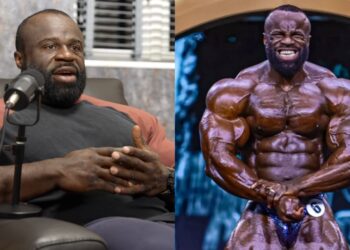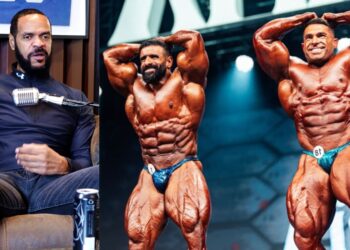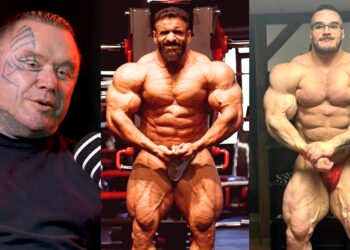After introducing the benefits of minimalist training principles, fitness expert Jeff Nippard recently shared a minimalist training routine that people at all fitness levels can follow. Nippard is a Canadian natural bodybuilder, powerlifter, and fitness trainer. He is known for his science-based content and has amassed close to 3.5 million YouTube subscribers. Nippard won the Mr. Junior Canada title in 2012. He also held the Canadian national record for bench press in 2014. He has trained many natural bodybuilders in the women’s bikini divisions, men’s divisions, and powerlifting. Along with the practical knowledge gathered through years of training and coaching, Nippard’s expertise comes from a bachelor of science degree in biochemistry.
As explained by him in the previous video, a minimalist training approach is among the most effective ways to get maximum benefits with the least amount of training in terms of time and volume. While this may come across as a lazy man’s training routine to a typical bodybuilding enthusiast, it is not quite the case. Fitness forms a part of life for a majority of individuals and is not their entire life. As a result, it is difficult to adhere to a maximalist training method that involves training as frequently as possible for making gains. However, this is where minimalist training can benefit millions of people.
Generally, minimalism refers to sticking to a bare minimum. The subject can be arts, architecture, design, and even lifestyle and fitness routines. In his previous video, Nippard explained the efficacy of the minimalist training principle in building strength and muscle mass and improving overall health. Recently, Nippard took to his YouTube channel and shared a minimalist training routine.
The training routine includes two full-body workout sessions per week and can be modified to spread out over more training days as per requirement. So without further delay, let’s explore how you can start your minimalist training journey.
Level Up Your Fitness: Join our 💪 strong community in Fitness Volt Newsletter. Get daily inspiration, expert-backed workouts, nutrition tips, the latest in strength sports, and the support you need to reach your goals. Subscribe for free!
Jeff Nippard’s two-day-per-week minimalist training routine
Minimalist Training: Day 1
Flat Dumbbell Press
This first exercise is a compound movement that targets the upper body pushing muscles. Experts believe that most of the strength gains are made in the first set as long as you expose yourself to heavy weights. Therefore the first set of flat dumbbell presses should be a heavy set with four to six reps for strength gains. However, there is a positive correlation between training volume and muscle hypertrophy. Therefore the second set should be a relatively light back-off set with eight to ten reps for building muscle.
But hold on a second… If exposure to heavier weights is a prerequisite for strength gain and not volume, you may question the use of dumbbells for this exercise rather than a barbell. After all, you can lift a lot heavier on the barbell bench press, right? So, here’s the answer in Nippard’s own words:
“First, dumbbells are generally more time efficient because you don’t need to load and unload any plates which chew up some time. Second, dumbbells allow a greater range of motion than a barbell. This normally isn’t a big deal because we can compensate for the barbell’s minor limitations by including a stretch-focused exercise like a cable fly. However, on a minimalist routine, you’re trying to minimize the number of exercises you do. So in this case, it makes more sense to choose the pressing exercise that also provides a large stretch to the pecs. So a dumbbell press or a dip will probably be your best option!”
Dumbbell Romanian Deadlift
Once again, dumbbells are preferred here to save time. However, the overall biomechanics of the movement is similar to the standard barbell RDL.
“The main thing to keep in mind with the RDL is to simply push your butt back as you allow the weight to drop straight down under control. Don’t think about lowering the weight to touch the floor. Simply set your hips back and let the dumbbells naturally lower in a straight line, reversing the motion once you feel a big stretch in your hamstrings without allowing the lower back to round…”
Nippard explained that he does not like to fully lock out at the top, allowing him to keep a constant tension in the hamstrings. However, locking the hips at the top and squeezing the glutes together can help activate the glutes a little more.
2-Grip Lat Pulldown
This will be the third and final exercise of the day to work the back and biceps. Nippard advises doing the first set with an overhand medium grip to work the mid-back and the lats. For the second set, he advises using an underhand close grip for focussing on the biceps while working the lats from a slightly different angle.
“After the second set, to get a little more biceps work, you can strip the weight back and do some overhead curls. This way we’ll make sure the high-threshold biceps fibers experience a high level of muscular tension as well,” Nippard added.
Dumbbell Step-up
This should be the main quad and glute-focused movement of the day. Speaking about the correct technique to get the most out of the only working set of this exercise, Nippard said:
“We want to be forcing our front leg to carry all the load to minimize cheating with your back leg as much as possible. Remember that the back leg is just there for keeping the balance. I prefer to work each leg – one leg at a time. That way you’re not losing tension in between reps which can really drag the set out.”
To reach failure at the end of the set for maximum strength gains, you should use heavier weights than normal. Nippard advises using straps if your grip strength is the limiting factor in this exercise.
Overhead Cable Triceps Extension
While a regular triceps pushdown would seem like a more obvious choice for many, it becomes redundant in this specific workout. Why? The first exercise — a flat dumbbell press — is a compound movement that works the triceps from a neutral position. Working the same muscle from a different angle using the overhead cable triceps extension can help in overall development. Therefore, overhead cable triceps extensions are a good alternative, especially when running short on time. After reaching failure at 12 to 15 reps in the first set, reduce the weight by approximately 30 to 40 percent and do a drop set to failure.
Machine Lateral Raise
This lateral deltoid movement should serve as the final upper-body exercise of the first training day. While Nippard performs this exercise on the Atlas standing lateral raise machine, you can do it on any machine or with dumbbells.
Horizontal Calf Press
Excluding the calves makes no sense if the goal is to do a full-body workout. The horizontal toe press and standard calf raises are not very different from each other when it comes to activating the calves as your legs are straight in both. However, Nippard prefers the horizontal toe press because the upper body does not have to bear the load in this exercise, which helps him build a better mind-muscle connection.
Overall, the Day 1 workout should include:
- Treadmill: 2 to 3 minutes
- Dynamic Warm-up: Arm Swings, Leg Swings, etc. for 2-3 minutes
- Flat Dumbbell Press: 2 sets (Set 1: 4-6 reps, Set 2: 8-10 reps)
- Dumbbell Romanian Deadlift: 2 sets of 8-10 reps
- 2-Grip Lat Pulldown: 2 sets of 10-12 reps (Set 1: overhand medium grip, Set 2: underhand close grip)
- Dumbbell Step-up: 1 working set of 8-10 reps (per leg)
- Overhead Cable Triceps Extension: 1 set of 12-15 reps and 1 drop set
- Machine Lateral Raise: 1 set of 12-15 sets and 1 drop set
- Horizontal Toe Press: 1 set of 12-15 reps and 1 drop set
Minimalist Training Routine: Day 2
Hack Squat
Day 2 of the minimalist training program should start with this compound movement to work the lower body. Once again, reducing the time and training volume is the key here. Compound machine movements typically require less number of warm-up sets compared to their free-weight counterparts. Therefore it is beneficial to use a hack squat machine rather than regular barbell squats in the minimalist training routine.
“With barbell back squats, it will sometimes take me half an hour just to get all my warm-up sets done. Whereas with the hack squats, I’ll do maybe two quick warm-up sets, and then I’m ready for the working sets within five to ten minutes tops!” Jeff Nippard added.
Get Fitter, FasterLevel Up Your Fitness: Join our 💪 strong community in Fitness Volt Newsletter. Get daily inspiration, expert-backed workouts, nutrition tips, the latest in strength sports, and the support you need to reach your goals. Subscribe for free!
He then explained a typical method he uses to do this exercise and said:
“For the heavy top set, I’m choosing the weight that’ll have me about one rep shy of failure. So an RP of nine for four to six reps. Here, I am just focusing on moving the weight. I’m thinking about driving through my heels while maintaining consistent pressure against the shoulder pads. Then I’ll rest for about three minutes. For the back-off set, I’ll drop the weight back and this time, focus a little more on controlling the negative — feeling my quads working.”
Superset: High Incline Smith Machine Press and T-Bar Row
This antagonistic superset for working the chest and back should be the next exercise in your second day of the minimalistic training routine. While regular supersets can include exercises targeting the same or different muscles, an antagonistic superset involves exercises that target opposing muscles like chest and back, biceps and triceps, or quads and hamstrings. What is the benefit of an antagonistic superset? Well, in this particular superset, the back muscles rest when you do the chest exercise and vice versa. This results in an overall reduced workout time, and at the same time, you will train different muscles.
Nippard advised setting the angle of the incline bench a little higher — 45 to 60 degrees — to involve the deltoid muscles to a greater extent.
“Rather than doing both the vertical press and horizontal press, we’re just meeting in the middle with the high incline press to save time. This will do a good job of hitting the pecs and the shoulders with a single movement. We’re also taking a slightly closer grip so we can take the triceps through a greater range of motion, and this will shift some of the emphasis to the upper pecs as well, which is a weak point for most people.”
If your gym has the Smith machine and T-bar row set up far apart, you can replace the T-bar row with incline dumbbell rows. Nippard advised taking a 30-second break in the middle of the superset.
“Just because you’re super setting, doesn’t mean you need to go straight into the other exercise. Getting a little rest in between to catch a breath is a good idea,” Nippard said.
Seated Hamstring Curl
Nippard cited a 2020 study that concluded seated hamstring curls delivered better results than lying hamstring curls on subjects over a 16-week period.
Nippard stated that seated hamstring curls are more beneficial because of the higher degree of hamstring stretch you get. To accentuate this stretch further, Nippard prefers to lean forward on the machine throughout the set.
EZ Bar Curl
This biceps exercise follows the hamstring curls. Since you will perform only one heavy set of this exercise, Nippard suggested making sure it is done in a perfect manner to get the most out of it. For maximum gains, focus on squeezing the biceps and maintaining a loose grip on the bar so that the forearms don’t take over the movement. Also, try to move the weight up and out by driving through the pinky for supination.
“After hitting failure with good technique, we’re doing some mild reps to enhance the set further rather than a drop set this time. So this time we’re keeping the weight the same rather than dropping it back and simply resting for three to four seconds and then doing another four reps.”
Nippard advised continuing the mild reps to failure. According to him, the mild reps allow you to get in a lot more high-tension reps in a short period.
“It isn’t until the very end of the set that reps become maximally hypertrophic. So by doing these mild-rep minisets, since you’re already close to failure, you’re essentially cutting any of those early low-tension reps and get straight to the more effective stuff.”
Cable Crunch
This core exercise will serve as the finisher of the second day of training. Nippard prefers to do this exercise by kneeling down and getting a good abdominal squeeze. After reaching failure at 12 to 15 reps in the first set, Nippard advised shaving off 30 to 40 percent of the weight for the first drop set and then doing the second drop set by reducing the weight by another 20 to 30 percent.
Overall, the workout should include:
- Hack Squat: 2 sets (Set 1: 4-6 reps, Set 2: 8-10 reps)
- Superset — High Incline Smith Machine Press: 2 sets of 10-12 reps and T-Bar Row: 2 sets of 10-12 reps
- Seated Hamstring Curl: 1 set of 10-12 reps and 1 drop set
- EZ Bar Curl: 1 set of 12-15 reps and 1 drop set
- Cable Crunch: 1 set of 12-15 reps and 1 double drop set
How to modify this training routine to include more training days and volume? Nippard explains
While following a full-body workout two days a week is not a bad thing by any means, there are multiple reasons why one might want to change things up a little. Some people may want to increase the training volume as their fitness level increases. Others might want to split the full-body workouts and incorporate shorter training sessions spread out throughout the week. Whatever the reasons may be, Nippard shared different methods to modify the training routine.
Alternative routine for training 1-4 days per week
For this alternative, Nippard advises splitting the upper and lower body exercises of the aforementioned two full-body workouts and spreading them across four training days.
- Mon: Upper Body 1
- Tue: Lower Body 1
- Wed: Rest
- Thu: Upper Body 2
- Fri: Lower Body 2
- Sat: Rest
- Sun: Rest
“And again, you can add some volume to these workouts if you find them a bit too short,” Nippard added.
Alternative routine for training 2-5 days per week
To split the workout over five days a week, Nippard advises splitting the first full-body workout into upper and lower-body workouts. However, the second day gets split into three — push, pull, and legs day.
- Mon: Upper Body 1
- Tue: Lower Body 1
- Wed: Rest
- Thu: Push
- Fri: Pull
- Sat: Legs
- Sun: Rest
While these splits give you a basic idea about the flexibility of this training routine, there is no limitation to the permutations and combinations you can try as you gain more experience. So, if you are running short on time or don’t know where to start, give Nippard’s minimalist training routine a try and start your fitness journey today!
You can watch the full video below, courtesy of Jeff Nippard’s YouTube channel:








